By Winkie Motley
Lifestyles in Keswick and its environs
By Keswick Life
By Keswick Life
By Winkie Motley
Shortly after World War II, a group of Virginia Foxhunters wanted to hold a hunter trial for horses that had been hunted regularly for the past hunting season from each hunt within the State of Virginia. The masters from each hunt were to nominate two horses to represent their hunt in a class which they called the Virginia Field Hunter Championship. It is generally believed that Truman Dodson, MFH, Farmington Hunt Club and James “Jimps” Blackwell were the first organizers of the event.
This competition under hunting conditions was to begin a yearly event to select the best hunting horse in Virginia. The rider and winning horse would in the future be the field master for the next year. The winning hunt would then be expected to host the hunter trial.
The first event was a huge success and immediately became a fiercely competed annual affair which had been held every year since 1950. The event attracted the best hunting horses in Virginia and those that regularly foxhunted. Billy Greenhalgh, Paul Mellon, Cappy Smith, Aleaxander Rives and Alexander Mackay-Smith rode in this event as often as they could from the 1950’s through the 1970’s. The present trophy is the Billy Greenhalgh trophy donated by his friends. The Keswick Hunt Club has been fortunate enough to win the Hunter Championship 6 times. It was won twice by Mrs. W.H. Perry riding One More Pennant, and twice by Alexander Rives riding Wedgewood and LaBarron. Sandy Rives won the championship in 1984 riding Ms. Teddi Ismond’s Dark Ivory. Will Coleman ‘s Sherman representing the Keswick Hunt Club won in 2003 and then again this year (2016) riding First Ace.
November 6, 2016 the Farmington Hunt Club hosted the 2016 Virginia Field Hunter Championships at the hunt club kennels on Wesley Chapel Road, Free Union, VA on a perfect Sunday fall afternoon. A full crowd of friends and spectators watched Carolyn Chapman, 2015 champion as she led a field of 15 riders representing eight hunt clubs from around the state. Keswick had two riders: Jennifer Nesbit and William Coleman Sr. Bedford sent Sarah Baker and Lorin Shellenberger, Loudon Fairfax was represented by Larry Campbell and Astrid Harber, Middleburg’s Devon Zebrovious won the prize for “Best Turned Out” and Teresa Croce won Reserve Champion on Graylord Woods. Old Dominion was represented by Sarah Crocker, Piedmont’s Mclelle Craig competed along with Rockbridge’s Elizabeth Hall, Warrenton’s Amy Robinson and Beth Woodson.
This prestigious competition follows a unique format. The Masters of each Virginia hunt are invited to select two of their members to compete, and the winning rider’s hunt hosts the competition the next year. Will Coleman, representing Keswick Hunt, won the championship on his handsome chestnut, Flying Ace.
The organizers were particularly pleased that so many spectators also attended to support their riders. The judges’ panel included Farmington members Pat Butterfield, MFH, Tom Bishop, ex-MFH, Mark Thompson Farmington Hunt Club president , and Robert Ashcom , a past champions. The three phases of the event were held in the honest hunt country of rolling cattle pastures and wooded creekbeds opposite the kennels near Free Union, Virginia.
The afternoon began with the under saddle section, followed by presentation of Best Turned Out, won by Middleburg’s Devon Zebrovious. The riders then followed 2015 champion, Carolyn Chapman, on a simulated hunt through fields, up and down trappy hillsides at the foot of the Blue Ridge, and over various obstacles including in-and-outs across gravel driveways. This section, observed by mounted and car-following judges, fairly simulated the unpredictable challenges of the hunt field and required alert riders and mannerly mounts.Finally, the judges asked all riders to perform an individual test over the outside course.
This win means that Keswick will have the honor of hosting this event in 2017. Remembering back to November, 2004 when Will hosted the event at Tivoli, all can look forward to a fantastic Virginia Field Hunter Championship.
By Keswick Life
With thanks to Norman Fine “Foxhunting Life” with additions from Keswick Life
Watercolors by Larisa Zorina
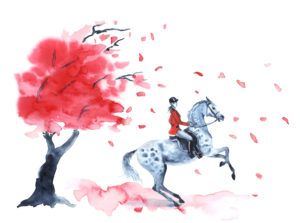 This year 2016/17 being the 120th season of the Keswick Hunt Club, we often need to refresh the traditions and etiquette of this age old sport. Foxhunting is meant to be a fun sport, after all most foxhunters have risen early, cleaned a horse, tack, clothes etc. shipped to the meet and then are expecting a fun morning in the sport.
This year 2016/17 being the 120th season of the Keswick Hunt Club, we often need to refresh the traditions and etiquette of this age old sport. Foxhunting is meant to be a fun sport, after all most foxhunters have risen early, cleaned a horse, tack, clothes etc. shipped to the meet and then are expecting a fun morning in the sport.
Foxhunting has been a countryside tradition for many years. Hunting on horseback began in the Middle Ages; however, during the 16th Century the British developed foxhunting into the aristocratic sport that it is today. All civilized societies adopt rules of etiquette and conventions that allow individuals to interact without conflict. By the same token, unique activities, and especially those involving a measure of risk (motor driving, sailing, foxhunting), develop of necessity their own unique rules and conventions to help assure a safe and pleasant outcome at the end of the day for all participants.
Thus, the courtesies and conventions of the hunting field, developed over the centuries, aim to produce an environment in which an exuberant sport may flourish pleasurably and safely. As each new season begins, it is never inappropriate to remind ourselves of the courtesies at the beginning of the meet, all from the master, hunt staff and field should greet each other with a pleasant “Good Morning” starting the day to the “Moving Off” sound of the huntsman’s horn, awaiting a fun day of sport.
Landowners
If there is one single overarching concept to understand about foxhunting, it is that we are guests on someone’s land and enjoy our sport solely through his/her goodwill. Without the landowner’s hospitality, there is no hunting. The question is: How do we maintain that goodwill? We answer that question every hunting day in the way we treat our landowners’ land, crops, and livestock.
• In general, commit no act that might test the landowner’s goodwill.
• Greet the landowner cheerfully and respectfully if you should see him/her.
• Arrive at the meet early enough to get tacked up and mounted before hounds move off. The Master does not want latecomers straggling over the landowner’s country, and the huntsman does not want latecomers heading the fox if it has circled back. If you are unavoidably late, stay to the roads after mounting up and wait for the best opportunity to join the field.
• All gates should be left as you find them. Closing a gate that was open might deprive livestock of their access to water. Leaving a gate open that was closed may allow livestock to escape or mix improperly with other stock. When in doubt, close the gate and tell the Field Master what you have done.
• If the field is passing through a gate, listen for the command as to what to do with the gate. If it is to be closed, you will hear, “Gate please.” If it is to remain open, you may hear no command at all, but you may hear, “Gate open.” In either case it is important that you acknowledge with a signal that you have heard the command. Likewise, if you are giving the command to those behind you, be certain your command is acknowledged. That is the only way to be certain the command was heard.
• If a gate is to be closed, it is the responsibility of the last one through to close it. It is common courtesy for one or two riders near the back to remain behind to help if necessary and to keep the gate-closer’s horse company.
• Never leave a gate for the second field or the hilltopping field to deal with unless they are close enough to acknowledge their understanding of what must be done.
• If a fence is damaged and cannot be repaired on the spot, advise the Field Master immediately so he or she can make appropriate and timely arrangements for its repair.
• Stay to the edge of all crop fields and seeded fields. If field members are crossing a pasture, it is best to spread out rather than erode a single track across the field.
• Slow down if livestock are running. Walk past dairy cattle. Walk past livestock during the calving, foaling, or lambing season. Do not ride between livestock and their offspring.
• Do not jump fences unnecessarily. You might break one and needlessly create a situation you have to resolve.
• Keep up with the field. If you are having difficulty keeping up, ask to be excused and fall back to the second field or the hilltopping field. Neither Master nor huntsman wants to see riders or small groups strung out across the country. The Master is concerned about the landowner, and the huntsman is concerned that if the fox doubles back it might be headed and the hunt spoiled.
• Unless you have specific personal permission, do not hack across private property on your own. Permission granted to the hunt does not bestow similar privileges on individual hunt members.
• Do not litter. Carry used food wrappers back home in your pocket.
• If you choose to leave the meet early, ask the Field Master if you may be excused and ask his advice regarding your route back to the meet. In general, you should hack back on the roads so as not to disturb any covert yet to be drawn.
• Do not sweep manure from your trailer at the meet. The landowner does not need your mess, nor should he have to worry about your horse’s de-worming regimen.
Master and Staff
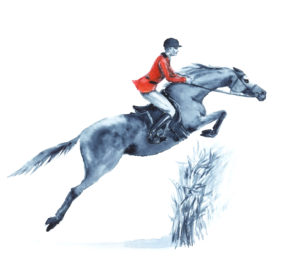 It is a Master’s responsibility to set the example and enforce hunt standards to make a day of foxhunting enjoyable for the field. The ideal Master of Hounds possesses many exceptional qualities; a love for hounds, horses, nature, wild animals and conservation; a consuming passion for foxhunting’s lifestyle; a dedication to organizing the best hunt and best sport possible; a willingness to sacrifice much personal time for the good of the hunt, realizing that the reward will be the privilege of being a Master of Foxhounds; and a willingness to live by a time-honored code of ethics that identifies you as a gentleman or lady and establishes that your word is your bond.
It is a Master’s responsibility to set the example and enforce hunt standards to make a day of foxhunting enjoyable for the field. The ideal Master of Hounds possesses many exceptional qualities; a love for hounds, horses, nature, wild animals and conservation; a consuming passion for foxhunting’s lifestyle; a dedication to organizing the best hunt and best sport possible; a willingness to sacrifice much personal time for the good of the hunt, realizing that the reward will be the privilege of being a Master of Foxhounds; and a willingness to live by a time-honored code of ethics that identifies you as a gentleman or lady and establishes that your word is your bond.
In the early days of foxhunting, most Masters were born into the sport. Most hunts were private packs and the Masters had the means, owned the land and managed their own hounds and hunt. They invited friends and neighbors to hunt with them, and often the children of these Masters took over as age or circumstance dictated, keeping hunts within families. With few exceptions, those days are long gone.
While now there are a few Masters who are wealthy and a few who make it on a shoestring, today the average Master is middle income. Most Masters are either elected or appointed to office, depending on whether the hunt is a subscription or membership pack. Private hunts are the rare exception. It is estimated the average Master’s term of service is eight (8) years, so Masters come and go fairly frequently, often with little direct experience to prepare them for mastership.
Short masterships are detrimental to hunts in many ways. One needs time to learn and develop knowledge of and friendship with landowners, to make competent and well considered breeding decisions, to earn respect from hunt staff, members or subscribers and develop wisdom about all aspects involved in maintaining a first class pack of hounds. These necessary talents are hard to develop with short-term masterships. Masters who were brought up by a father or mother and lived in the hunting life, who hunted as children and were tutored by parents who were Masters are extremely rare.
At least one Master should always be present on hunting days. Good organization is the key to good sport. It stems first and foremost from good relationships with your landowners whose land you may access. It is also vital to have the good will of lessees of the land you hunt. The Master organizing the day’s hunting should do the following: contact landowners and lessees whose land is likely to be used that day to seek permission for that particular day’s hunting. Ensure the Master and huntsman recognize farmers by name and show courtesy to landowners or farmers that you encounter on the day. Whenever possible get off your horse when meeting them and take off your hat. Instruct your field to smile, wave and get out of the way of anyone they come across. The best time for the Master to visit all landowners is prior to Autumn hunting.
The Huntsman controls the hounds, indicating to them by signals where he wishes them to draw for a fox, and he is responsible for a fox being well hunted when found. His technical decisions must be quickly made, and staff and Field must abide by them or utter chaos will ensue. As the Huntsman is quite often a professional he originally was described as a Hunt Servant and in the modern world of Foxhunting, the Huntsman should also realize he must be respectable, smart and clean in appearance, civil and well-mannered. The character of the hunt may be fairly judged by the manners and turn-out of the servants.
The Whippers In assist the Huntsman in controlling hounds by turning them back to the Huntsman or by encouraging them forward to him as necessary. Also, they are used by the Huntsman as scouts to get notice of the movement of a fox. No one except the Huntsman gives orders to Whippers-In. No one except by request of the Huntsman or MFH should accompany them or attempt to assist them.
The Field
• Greet the Master politely upon arriving at the meet. Thank him and thank the staff at the end of the day. When departing, it is correct to say, “Goodnight,” even if it’s still morning!
• Don’t talk to the huntsman during the hunt. His attention is and should be elsewhere.
• Never come between the huntsman and his hounds.
• Don’t crowd the huntsman or his hounds.
• Don’t pass the Field Master. Follow, but don’t press. He is constantly revising his planned route based on how hounds are running, what the huntsman is doing, and how the terrain is unfolding.
• Be quiet when the Field Master stops. He is listening for hounds.
• The whippers-in and the huntsman have the right of way. Always defer to them and allow them room to pass. When standing, always point your horse’s head toward them as they pass.
• Never talk to a whipper-in during the hunt. His huntsman demands that he keeps his full attention on the hounds and the quarry. Any distraction at the wrong moment that causes him to miss something he should have seen can irretrievably ruin a hunt.
Hounds and Quarry
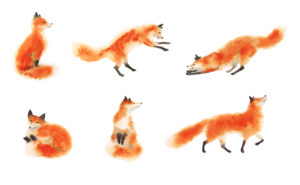 • Hounds always have the right of way.
• Hounds always have the right of way.
• The worst crime one can commit in the hunting field is to allow one’s horse to kick a hound. You must do everything in your power to train your horse against this vice or punish your horse immediately if he commits such a crime.
• Never ride ahead of hounds or ahead of the quarry. Never get between hounds and the quarry.
• When hounds are drawing for a fox or casting after a check, remain still and quiet so as not to distract them.
• In general, never speak to a hound. That is the job of the huntsman and whippers-in.
• If hounds come near to you, turn your horse’s head toward them.
• If you view a fox, never startle it with a holloa. Its scent will change, and hounds will be confused. Wait quietly until it is some distance from you, then tell the Field Master what you have seen. Let the Field Master make the decision whether or not to holloa. If hounds are hunting well, the huntsman will not want to lift them and will not want them distracted.
• Do not bring an unprepared horse into the hunting field. Of greater concern than the danger to yourself is the danger you pose to other innocents.
• If your horse is fractious or out of control, remove him from the hunt field immediately. Don’t bring him back until you have solved his problems.
• If your horse kicks out at other horses occasionally, braid a red ribbon into his tail and keep him in the back of the field. If he cannot be cured of the vice, find another job for him away from the hunting field.
• If someone is riding too close behind, and you are afraid your horse may resent it, place one arm behind your back, forearm horizontal at the waist, palm out. This is a universal warning that your horse might kick. Likewise, if you see the rider in front give you such a signal, fall back.
• Do not allow your horse to nuzzle, nip, or rub the rump of the horse in front of you. Even a non-kicker can be provoked to kick.
• Do not coffee-house and chatter while hounds are hunting, even if you are far removed from the pack. Other field members are trying to watch and listen.
• When warning other riders of holes or other hazards (i.e., ’Ware hole, ’Ware wire, etc.), turn and speak loudly enough to be heard only by the riders immediately behind you. Do not shout the warning so as to distract hounds. Point to the hazard with your whip, crop, or finger. If the warning has been repeated several times before you arrive at the hazard, and you think the people behind you are already alerted, it may only be necessary for you to point at it.
• When queued at a jump, be certain the rider in front of you is safely over before you jump.
• If your horse refuses a jump, go to the back and allow the other field members to jump ahead of you and go on. Everyone wants to keep up with hounds, and it is rude to prevent them from doing so if your horse is being obstinate.
• Before bringing a guest to your field, seek permission from your Master. If you bring a guest, introduce him to the Master as soon as possible. Your guest is your responsibility. Acquaint him with any local protocol and stay nearby to assist him.
By Keswick Life
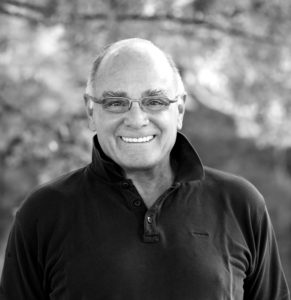 Tony Vanderwarker has just released a new book, I’m Not From the South But I Got Down Here As Fast As I Could – How a Connecticut Yankee Learned To Love Grits and Fried Green Tomatoes And Lived To Tell About It. I caught up with Tony to get a candid look at the author’s background, the new book, the writing process and life in general.
Tony Vanderwarker has just released a new book, I’m Not From the South But I Got Down Here As Fast As I Could – How a Connecticut Yankee Learned To Love Grits and Fried Green Tomatoes And Lived To Tell About It. I caught up with Tony to get a candid look at the author’s background, the new book, the writing process and life in general.
Keswick is full of diversity. Historic farms with manicured road fronts flank the cottages, bungalows, and the more modest dwellings. It has working people, stay at home people, business types, caregivers, families, white-collar types, and a few billionaires. The friendly people in Keswick come from near and far, from the ‘North’ and the ‘South,’ some from other places and some have been here all along. Home is comfort – it is where you can be yourself, let your guard down and just relax. The ‘community’ where the stories are born, the bonds are made, and you build a life with ‘your’ people. The parties, some quite famously, are the melting pot for the young and old, the working and the leisure types. All the faces are familiar, whether you are at a backyard pig roast on Clarks Tract or in a barn transformed in honor of ‘the big’ night of the moment. While waking up in the Keswick world, at times, the rest of the world seems so far away. We come to Keswick and find a guy next door. In case you’ve missed him, his name is Tony Vanderwarker.
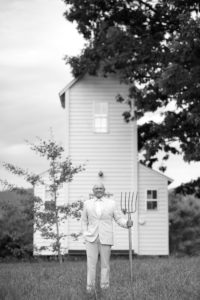 I met Tony to do this article at my studio at Liberty Park, a former factory building, in Gordonsville, located just behind a Food Lion located in a quaint small town strip mall with a menagerie of mostly eating-places. The plant, an all too typical modern American story, closed down after the lace fabric they produced could be done for less outside of the United States, three shifts of 625 people lost their jobs nearly overnight. He quickly found my space amongst the in progress rehabilitation of the factory to smaller flex spaces, he has an unmistakable confidence, with a street smarts sensibility – familiar and highly self-aware. He is 70, sharply dressed but mostly casual, has a distinctive style, a warm smile, a kind soul and shaves the stubble from his head every morning. We arranged some comfortable seats and sat down. He looked at me and smiled.
I met Tony to do this article at my studio at Liberty Park, a former factory building, in Gordonsville, located just behind a Food Lion located in a quaint small town strip mall with a menagerie of mostly eating-places. The plant, an all too typical modern American story, closed down after the lace fabric they produced could be done for less outside of the United States, three shifts of 625 people lost their jobs nearly overnight. He quickly found my space amongst the in progress rehabilitation of the factory to smaller flex spaces, he has an unmistakable confidence, with a street smarts sensibility – familiar and highly self-aware. He is 70, sharply dressed but mostly casual, has a distinctive style, a warm smile, a kind soul and shaves the stubble from his head every morning. We arranged some comfortable seats and sat down. He looked at me and smiled.
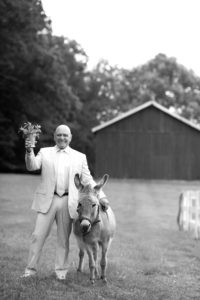 Tony grew up in quintessential northern suburbia, Connecticut, with working parents who wanted a better life for themselves and their two sons. A young Tony would follow the course his parents set for him. He attended the highly selective, preparatory high school for boarding students, Phillips Andover in Massachusetts. He was being groomed, “set up to meet the perfect blond haired Daddy’s girl” he quips, with the wealthy family and get the comfortable life. Tony thought, “what is all this business,” knowing deep inside that this doesn’t feel right. His parents befriended others who had something that they desired themselves, social climbers, who thought the rich walked on water. Among the many things imparted from parent to child, they described to Tony and his younger brother a South that was full of hillbillies – not their type of individuals.
Tony grew up in quintessential northern suburbia, Connecticut, with working parents who wanted a better life for themselves and their two sons. A young Tony would follow the course his parents set for him. He attended the highly selective, preparatory high school for boarding students, Phillips Andover in Massachusetts. He was being groomed, “set up to meet the perfect blond haired Daddy’s girl” he quips, with the wealthy family and get the comfortable life. Tony thought, “what is all this business,” knowing deep inside that this doesn’t feel right. His parents befriended others who had something that they desired themselves, social climbers, who thought the rich walked on water. Among the many things imparted from parent to child, they described to Tony and his younger brother a South that was full of hillbillies – not their type of individuals.
In school, Tony was a frustrated artist, deeply embedded in this life but not of his making – not yet able to break out of the rut. At Andover, his advisor works up a Morehead Scholarship opportunity for consideration in North Carolina. Tony explains, “I felt like, was that all I was capable of, a school down in the South, in North Carolina, where is that exactly, and is this all this guy thinks of me?” He ends up at Yale, and for the proud parents, all seemed to be on track. Tony explains he had an epiphany during his sophomore year, bagged his mother’s vision of his life and quit Yale. Ambitious to flourish in the change up, Tony joins the Peace Corps and heads to Africa. Spends a year there and gets inspired by film then back to school, this time at NYU. In a cinema program, Tony flexes his creative muscles, finds comfort in his skin, graduates with a degree in Cinema and makes a full-length theatrical film – it is the late 1960’s.
Next up, sick of freelancing in the movie business, he moved to Chicago to get into advertising. He had a rapid rise in the ad biz first as a copywriter, then as creative director where he worked on McDonalds’ “twoallbeefpattiesspecialsauceletture cheese”, “Big Mac Attack” and then, when he started his own agency with two partners, did “Be Like Mike” for Gatorade. During a visit to Chicago by his parents, Tony was walking them around his two-hundred person, $180 million in billings agency when his mother reverted to form and asked, “Don’t you miss being back at the agency that was listed on the New York Stock Exchange?” His father quickly reminded her, “But Patty, he owns this whole place.”
In Chicago, life is good, business is booming, and Tony meets Annie, they get married, and life is even better. Annie has two young boys of her own, they marry and have two more kids together with a house in the suburbs – a blended union, a modern fairytale. The partners, at the ad firm he helped to create, unexpectedly execute the buyout clause, which lands Tony on the sidewalk. So the question was, “Do we stay or do we go?” Stay in familiar territory or strike out and try something new. The moment came, albeit not entirely but surely it was a catalyst – while Tony and Annie were walking in the neighborhood they spot their two younger kids sipping fancy hot drinks in the window of the Starbucks along the walk to their school. Too much sophistication too soon, they thought. They decide to move to Charlottesville and take advantage of Annie’s family there for some support.
The indoctrinated Northerners settle into the Charlottesville area, first to Ivy then to Keswick. Setting all his predispositions aside, Tony embraced the South, the warmth, and fellowship of its’ rich culture and roll-with-it ways. And now, circuitously, they are in the South, and unexpectedly it would change them all for the better.
Tony Vanderwarker has written a memoir, dedicated to all he cherishes about his life changing move to the South. He quickly realized upon his move to Virginia, the South wasn’t filled with mountain people but instead he found the simpler way of life he was so eager to embrace for his family and his well-being. His ad agency partners might have given him one of the best-unwelcomed opportunities, despite the forced retirement and resulting relocation; a familiar story for many people in America today. For Tony, the South was warmer, in all the ways this word invokes, and in contrast made the North seem cold and distant. Here others are accepting of your way of life; there is little judgment and if there is it considered irrelevant.
The book brings Keswick to life; full of stories that were begging to be told. Tony explains, “My book is a love letter to Keswick. Not only is Keswick stunningly beautiful, it’s a marvelous place that asks to be brought to life. Here we have celebrities and billionaires living side-by-side with hairdressers, farriers, and farm managers. Tony and Annie offer cottages on their farm to the Airbnb service; the guests are amazed – they come from all over the world to see and share the magic of the area. The South is changing. We talk about the fancier foods, with sophisticated flavors that pay homage to their origins but now put the food on the world map. The greater Charlottesville area has broad appeal, with the downtown mall, world-class museums and living history experiences and exhibits at Monticello, all just a few miles apart.
The genesis of Tony’s book was the incredible response to his column “Only in Keswick” in this paper, where Tony began to tell his stories of the incredible people and amazing things that happen here. “You ought to put these together in a book,” more than one reader said. Stories like the ones about Chita Hall, who kept lions and bears (even reportedly an elephant) on her property, who would give cans of pop to her pet bear Betsy and delight in watching her perch on her haunches and glug the soda down. Or her husband Chet who trained his parrot to say salacious things. Once an encyclopedia salesman came to the door, the parrot invited him in and then said, “Sic him” to the Doberman who chased the terrified guy off the farm. Or the business tycoon who hits and kills a huge buck with his truck right in front of his farm and leaves the carcass to get help to dispose of the critter, Quickly returning, they find in the meantime, someone had stopped and used a chain saw to hack the head off the carcass in order to take the rack home for themselves, leaving the headless body behind.
The stories are true Keswick, wild and wonderful. Tony adds, “Everybody appreciates the leveling factor; no one looks down on anyone. The book is good-natured with the sense of ‘Isn’t it great to be living in this amazing place?'” Many of the stories are outlandish and could only happen here. For instance, the wedding that got rained out by bats dropping from the ceiling. One of his neighbors says, “There are no secrets in Keswick.” The writer feels that people in Keswick willingly share stories, tribulations as well as personal heartbreaks and hardship. “When someone gets sick or has a tragedy, the calls are made, the food starts to flow and countless, ‘How can I help?” calls go out.” This is quintessential Keswick, very Southern, and the way it has been done here for generations.
Tony has written millions of ads and a bunch of books, but it took him twenty years to get his first published. He has published three, Writing With the Master, Sleeping Dogs and Ads For God. The writing process seems to come naturally for Tony; it suits his seemingly systematic ways. He writes, standing up, for three hours in the morning, like it is his job, just five days a week and shoots for a thousand to twelve hundred words per day – he admits some days are slower than others.
Using a computer, he keeps the ideas flowing without getting hung up on shaping the story, which comes later. The ideas rush in for the books, sometimes while driving in a car, or at a cocktail party and they often don’t flesh out as quickly, they have to ruminate. Tony explains he is not a plotter; some writers he admires, like John Grisham, are outline-driven and develop characters with a clear path from beginning to end. Tony wings it, characterized by writers as pantsing (putting your pants–and what’s in them–in a chair) and writes without an outline. “You end up hitting the delete key a lot,” he says, “but it’s the way I feel most comfortable writing.” He says he’s become good at editing, “Bad writing is like hitting a wrong note or farting in church. I sniff ugly stuff out as fast as pigs do truffles.” Typos bug him, as they do all writers, “They are like ants, you think you’ve swatted them all and then another crawls out. I dread seeing them in my published books because I see them all the time in others.” He dismisses “writers’ block,” saying, “the writer creates it so he can destroy it.” Tony gives aspiring writers the following simple advice, a quote from Thomas Edison: “Many of life’s failures are people who did not realize how close they were to success when they gave up.”
“That’s my motto when it comes to writing, ‘Never give up; you never know when you’ll find your pay dirt.'” Tony started writing funny stuff, struck out a bunch of times, then tried non-fiction, Writing With The Master, then a thriller, Sleeping Dogs, but found humor (with Ads For God) was his niche. “Hiaasen, Dave Barry, and David Sedaris are my idols. But I get a kick out of some of my stuff too. And I absolutely love it when someone comes up to me and says, ‘Your article made me laugh my ass off!’ That’s one of the great rewards of writing for you guys (Winky and Colin at KL). People come up to me at the post office, at parties, it really brings my writing home.” Tony started writing stories for I’m Not From the South about three years ago. “When the book finally does come out (Nov. 17), it will feel like I wrote it ages ago.”
Our pantser is already working on his next book, titled, Visits to Venus, How a Man From Mars Can Survive the Marital Wars. Tony has fun playing with the differences men and women have as displayed in driving, parking, making beds, loading the dishwasher and other life-changing experiences. An excerpt from the new book was published recently in Keswick Life titled, ‘I Married a Garden Club’ – the response was immediate, he hit a nerve with husbands from all walks of life. Tony radiates infinite gratitude to have had these experiences with the books, the very personal stories and the people he meets in the process.
We have all heard it takes a village to raise a kid, well there are some people in Tony’s camp worth a mention. First, his family that enjoys his writing and are jubilant with him doing it. One son, a graphic designer, did the first three book covers. In general, they accept Tony and his creative tendencies as a way of life for them – each creative in their individual endeavors perhaps as a result of Tony’s example in his determination to release the caged and frustrated artist he recognized in himself so many years ago. Tony stresses that Annie, his wife, “is entirely on board with the writing, and that is great” and adds “the most important thing is she still laughs at my jokes.”
Tony uses Beta readers, known as a pre-reader or critiquer, a group of friends in his case; some who are writers as well. The group, which consists of mostly women, read his written work with the intent of looking over the material to find and improve elements such as grammar and spelling, as well as suggestions to improve the story, its characters, or flow. Done before public consumption of his material, the Beta readers are not explicitly proofreaders or editors, but serve him in that context. Mary Murray, in Charlottesville, designed the cover with a Grant Wood, American Gothic, feel with a bit of Green Acres mixed in. Sarah Cramer Shields, a local photographer, took the photograph. Duke Merrick is one of the people the book is dedicated to, as he threw the phrase out at a Keswick Hunt Club party in the intro to one of his songs, saying, “I saw a bumper sticker that read, I’m Not From the South But I Got Down Here As Fast As I Could.” Tony quickly scribbled it down, realizing it would characterize his book the way many titles don’t.
The publisher and publicist are keys to the success as it is their network of contacts that Tony uses to try to make the book stand out among the bombardment of eight hundred books or more published in the United States every day. He adds, “The publicist opens the world up to you, it is who they know as it is impossible to get on television and broadcast the message yourself.” Most well-written books that just don’t sell suffer from the fact that nobody noticed it, Tony comments “the headlines take over everything or sometimes it is just bad luck.”
His publisher, a small outfit in Mississippi, saw the potential in both the book and the title. Tony said, “Americans of any age, but particularly Boomers, are looking for alternatives.” And perhaps, I joke, a pitchfork and mint julep, too. He agrees and underlines the changing Southern culture as well as its more pleasant climate. His book has a memoir feel, a Year In Provence character, about the longing for something new and different (and maybe also cooler, cheaper and with more character). So far, he’s been pleased with the reactions, “If people like my Keswick Life stuff, they’ll love this.” And one of his Beta readers said, “I absolutely howled through the whole thing.” The Kindle edition is now up on Amazon and Tony watches the sales carefully, hoping that he’ll get enough before November 15 when it publishes, to qualify for Amazon’s bestseller list which catapults him up the Amazon ladder. If you are inclined to make an order today, I guarantee you won’t be sorry. In the meantime, Tony, who is always writing even if his hands aren’t on the keyboard, will be out there mowing the lawn listening to NPR or kicking back with Hiaasen’s latest in hand.
By Keswick Life
By Sharon H. Merrick
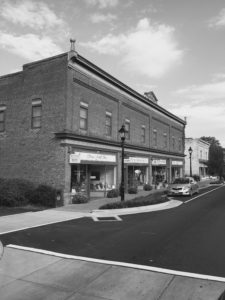 A new door opened in Gordonsville and beyond lies a treasure-house full of imagination, experience and magic! European antiques, stuffed toy animals, ladies’ fine accessories, Belgium crystal, French chandeliers and a Kangaroo Rocker are certain to capture your attention.
A new door opened in Gordonsville and beyond lies a treasure-house full of imagination, experience and magic! European antiques, stuffed toy animals, ladies’ fine accessories, Belgium crystal, French chandeliers and a Kangaroo Rocker are certain to capture your attention.
Let’s change the traditional Retail Paradigm and blend different passions and personalities….all under the same roof!
Jodi Myracle created Sugarbritches (nickname given to her by Grandmother) following a love for all things children; both new and old. Dissatisfied with mass production and all things similar, Jodi invites everyone to browse her curated collection of clothing & gifts and find that special something for a Child… new or timeless, but always unique and sure to bring excitement! Jodi and husband moved from Richmond several years ago…drawn to an old house in the Country and the beauty of Central Virginia. Friends teased they would quickly return to Richmond…but their “Green Acre” Journey remains happy in Orange.
When one door closes another door opens… but we so often look so long and so regretfully upon the closed door, that we do not see the ones which open for us.” —Alexander Graham Bell
Annette La Velle (originally from Chicago) and her Lindenlaan Antiques bring 40 years of experience; living in Flanders, Belgium, studying history and art in Paris and receiving her European certification as a dealer of antiquities. She’s a little rusty on the Southern accent but most charming when introducing her beloved collection with French and Flemish excitement! When asked her tips for Interiors, she quickly refers to Axel Vervoordt, a Belgian antiques impresario with HQ in Antwerp. (What did we do for quick reference before Internet??). Annette likes to search for “statement” pieces, typically large in scale and then blend old and new to create a calm and classic look. Annette’s partners help her source European treasures often found in Chateaus, Farmhouses & Monasteries. Her third container arrives this Fall and certain not to disappoint.
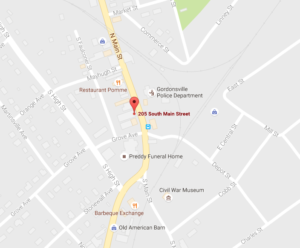 As for me and Jacqueline Gupton, we bring a few of our treasures into the Shop; French Antiques, European Fashion & Accessories and some special and unique Interiors from our Collections.
As for me and Jacqueline Gupton, we bring a few of our treasures into the Shop; French Antiques, European Fashion & Accessories and some special and unique Interiors from our Collections.
This Door proudly swings open Wednesday-Sunday, 11am-5pm or by Appointment.
By Keswick Life
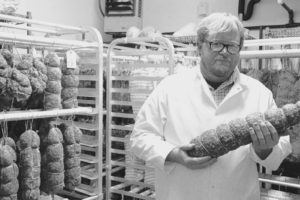 Nate Anda takes his meat seriously: a combination of classic culinary training, immersion in the art of charcuterie, and an unshakable commitment to the tradition of butchery has shaped every aspect of his work.
Nate Anda takes his meat seriously: a combination of classic culinary training, immersion in the art of charcuterie, and an unshakable commitment to the tradition of butchery has shaped every aspect of his work.
Raised in New Hampshire, Anda’s family later moved to Keswick and first started cooking as a teen, working under Chef Angelo Vangelopoulos at the Ivy Inn in Charlottesville, Virginia. There, and at subsequent internships that followed, he learned about the craft of charcuterie. Eager to make cooking his profession, Anda soon enrolled at the New England Culinary Institute in Montpelier, Vermont, where he took every course offered on butchery and charcuterie. Returning to his home region of the Mid Atlantic, Anda continued to hone his skills at Equinox Restaurant in Washington, D.C., and Salamander Market in Middleburg, Virginia. In 2004, he accepted his first executive chef role at Tallula in Arlington, Virginia, where he gained critical notices from USA Today and The Washington Post for his charcuterie, especially the house-made bacons.
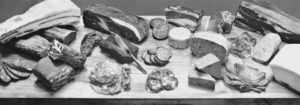 All the while, Anda continued to build upon his expertise with butcher-shop tours of Italy, fermentation and curing workshops at Iowa State University, and with an internship at The Fatted Calf in San Francisco. In 2008, Anda founded Red Apron Butchery, rooted in Italian charcuterie with a style that emanates from his endless experimentation and curiosity—using flavors from Asian chiles to Fernet Branca to enliven his program.
All the while, Anda continued to build upon his expertise with butcher-shop tours of Italy, fermentation and curing workshops at Iowa State University, and with an internship at The Fatted Calf in San Francisco. In 2008, Anda founded Red Apron Butchery, rooted in Italian charcuterie with a style that emanates from his endless experimentation and curiosity—using flavors from Asian chiles to Fernet Branca to enliven his program.
Through Red Apron, Anda has built close relationships with local farms that all raise their animals following sustainable and humane rearing practices, and many of which are Animal Welfare Approved. During production, he hand-grinds and mixes meats according to his personal, finely tuned recipes for the nearly 70 goods in the Red Apron larder. Each product is cased by hand, aged or smoked – often for months and under careful watch – until it’s just right. was long defined by the classic steakhouse.
Anda’s work earned him a Good Food Award in 2011 for charcuterie, and accolades from The Washington Post, Men’s Health, Bon Appetit, Washingtonian, Urban Daddy and others. Anda is pushing butcher-shop boundaries and making Red Apron home base for artisan charcuterie in the region, earning himself a StarChefs Rising Star Concept Chef Award in 2014.
Red Apron Butcher, a creative collaboration between Chef Nathan Anda, the Neighborhood Restaurant Group and a handful of dedicated regional farmers, is a locally sourced whole animal butcher and small-batch producer of handcrafted charcuterie and fine provisions.
Their philosophy is driven by an inflexible commitment to using only the finest all-natural, hormone and antibiotic free, humanely and sustainably raised beef, pork, lamb and poultry. They have spent years developing the relationships they have with their farmers, and have been recognized as the first American butcher shop to source 100% of its pork from Animal Welfare Approved farms, an organization whose standards are the most strident and rigorous in the nation.
Their craft is defined by an inimitable catalog of nearly 80 original artisanal products – all of which are 100% handmade and deliberately produced in small batches designed not merely to mimic traditional or familiar foods, but rather to introduce both new and innovative flavors inspired by old world technique.
Nathan Anda is the Butcher and Chef at Red Apron Butcher, an artisan butchery and small batch producer of handmade charcuterie founded in 2009, as well as The Partisan, its adjoining restaurant and bar. His combination of traditional techniques and culinary expertise has helped Red Apron emerge as D.C.’s definitive source for real and honest charcuterie, pâtés, salumi, terrines, sausages and more.
By Keswick Life
By Keswick Life
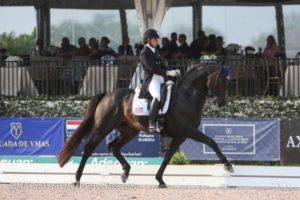 Allison Brock and Rosevelt, a 13-year-old Hanoverian stallion owned by long-time Brooke USA patrons Fritz and Claudine Kundrun will compete with Team USA in Dressage at the Rio Olympics. Brock and Rosevelt made their name on the national stage with a stellar performance at Dressage at Devon in 2014, earning double wins that foreshadowed their future success. Since then, they continued to make a name for themselves with multiple victories during the highly competitive winter season in Wellington, Florida. During their 2016 European tour they were consistent and scored well, earning themselves a spot on the U.S. Olympic team from a very competitive field. The Rio Olympics will be the first major championship team competition for Brock and Rosevelt.
Allison Brock and Rosevelt, a 13-year-old Hanoverian stallion owned by long-time Brooke USA patrons Fritz and Claudine Kundrun will compete with Team USA in Dressage at the Rio Olympics. Brock and Rosevelt made their name on the national stage with a stellar performance at Dressage at Devon in 2014, earning double wins that foreshadowed their future success. Since then, they continued to make a name for themselves with multiple victories during the highly competitive winter season in Wellington, Florida. During their 2016 European tour they were consistent and scored well, earning themselves a spot on the U.S. Olympic team from a very competitive field. The Rio Olympics will be the first major championship team competition for Brock and Rosevelt.
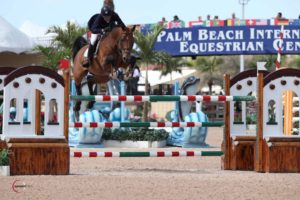 Hyperion Stud owner, Vicky Castegren recently announced that her prized stallion Imothep, has been short-listed for competition at the 2016 Rio de Janeiro Olympics, under Japanese rider and 5 time Olympian, Taizo Sugitani. A very joyous Vicky Castegren, said “I never thought that when I dreamed about qualifying for the Olympics it would be like this. As a rider I dreamed of it for myself, but as an owner I did not even conceive of it. Yet here I am almost astonished that after this wild ride we have all been on, we can legitimately say we have arrived. I am overjoyed with having the honor of being surrounded by such an incredible team who has brought us to this point, and I hope we are given the opportunity to represent each and every one of the people who have helped us along the way.”“I have had the honor of representing my home country in five previous Olympics, and have an extremely bright outlook for what we are bringing to the upcoming Olympics in Rio,” said Taizo. “I feel as though we are bringing a strong effort to Brazil, and the relationship between Imothep and myself is getting stronger and more comfortable as time goes on.”
Hyperion Stud owner, Vicky Castegren recently announced that her prized stallion Imothep, has been short-listed for competition at the 2016 Rio de Janeiro Olympics, under Japanese rider and 5 time Olympian, Taizo Sugitani. A very joyous Vicky Castegren, said “I never thought that when I dreamed about qualifying for the Olympics it would be like this. As a rider I dreamed of it for myself, but as an owner I did not even conceive of it. Yet here I am almost astonished that after this wild ride we have all been on, we can legitimately say we have arrived. I am overjoyed with having the honor of being surrounded by such an incredible team who has brought us to this point, and I hope we are given the opportunity to represent each and every one of the people who have helped us along the way.”“I have had the honor of representing my home country in five previous Olympics, and have an extremely bright outlook for what we are bringing to the upcoming Olympics in Rio,” said Taizo. “I feel as though we are bringing a strong effort to Brazil, and the relationship between Imothep and myself is getting stronger and more comfortable as time goes on.”
Sugitani has represented Japan in individual competition during every summer Olympics since Atlanta in 1996, with his best result to date being tied for 15th in Athens during the 2004 Games. Additionally, Taizo has been a part of team competition in the 1996, 2000 and 2004 Games, with Japan’s best result of those years being 11th place at the 2000 Sydney Olympics. In addition to Taizo’s Olympic experience, he has remained quite remarkable, as he has earned two Bronze medals in the 2014 Asian Games, six appearances at the World Equestrian Games and twice appearing in the World Cup Finals. Sugitani is currently ranked #177 in the world, according to the Longines FEI Jumping Rankings.
Castegren added, “I am a true believer that everything happens as it should even though the path can be difficult. Each and every one of the talented people who have been a part of Imothep’s education over the years have brought us to where we are today. When I take a look back at what we have accomplished as a group, since I purchased Imothep as a 6 year old in 2009, I am completely humbled at the level of success we have attained to this point. It brings me an immense amount of pride and joy to see everyone involved, especially Imothep’s trainer Craig Yates, acknowledged in this way. This is the pinnacle we all dream of in some capacity.”
As the highest ranked Japanese show jumper, Taizo Sugitani has been named to the four person team for Japan. Also representing Japan, his teammates are Toshiki Masui, Reiko Takeda and Daisuke Fukushimo, with Koki Saito as a reservist.Chef d’equipe, Hirokazu Higashira is expected to release the official horse and rider combinations within the next couple of weeks, as teams make final preparations for their travels to Brazil in August. Rio de Janeiro Olympic equestrian showjumping competition will begin on August 14, 2016.
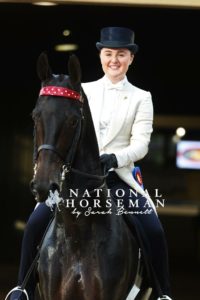 Stellenbosch, South Africa – The U.S. Saddle Seat World Cup Team traveled to South Africa to compete in the 2016 International Saddle Seat Equitation World Cup at the Mistico Equestrian Centre, July 7-9. The twelve U.S. athletes delivered excellent performances against teams from Canada, Namibia, and South Africa. Under the guidance of coaches David Cater (Dunbarton, N.H.), Pam Roush (Lutz, Fla.), and Kent Swalla (Columbia, Mo.), the Three-Gaited section won Gold and the coveted Three-Gaited World Cup trophy while the Five-Gaited section won Silver.
Stellenbosch, South Africa – The U.S. Saddle Seat World Cup Team traveled to South Africa to compete in the 2016 International Saddle Seat Equitation World Cup at the Mistico Equestrian Centre, July 7-9. The twelve U.S. athletes delivered excellent performances against teams from Canada, Namibia, and South Africa. Under the guidance of coaches David Cater (Dunbarton, N.H.), Pam Roush (Lutz, Fla.), and Kent Swalla (Columbia, Mo.), the Three-Gaited section won Gold and the coveted Three-Gaited World Cup trophy while the Five-Gaited section won Silver.
“We could not be more proud of the team as a whole and both the Three- and Five-Gaited teams had brilliant performances. More importantly, they came together as a team which made the whole event more meaningful.”The U.S. Team and supporters were thrilled with the final results announced at Saturday evening’s Award Ceremony. The Three-Gaited section of the U.S. Team received stellar scores to win its Gold medal with South Africa and Canada earning Silver and Bronze, respectively, and Namibia finishing in fourth.
The U.S. Three-Gaited section consisted of: Aleia Brown (Dayton, Ohio), Cameron Kay (W. Bloomfield, Mich.), Courtney McGinnis (Santa Barbara, Calif.), Faith Robbins (Carmel, Ind.), Kasey Saccocia (Halifax, Mass.)and Molly Codeanne (Wethersfield, Conn.)
In the Five-Gaited section, the U.S. Team rode well in the challenging competition to win the Silver medal with South Africa earning Gold and Canada collecting Bronze. The U.S. Five-Gaited section consisted of: Allie Poovey (Winston Salem, N.C.), Ashley Brandies (Jesup, Ga.), Ashley Stewart (Pfafftown, N.C.), Cailin Bridges (Salisbury, Mass.).Catherine Wheeler (Keswick, Va.), Rose Marie Wheeler (Anchorage, Ky.)
“It was amazing getting to represent my country and experience a new culture. Competing as a team in a normally individual sport was new but was a fulfilling experience. I am thankful that I got to compete with my fellow teammates, coaches and all involved in the World Cup”, said Catherine Wheeler.
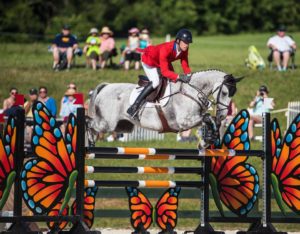 Fitch’s Corner is the private farm of Fernanda Kellogg and Kirk Henckels, located on 150 acres in the heart of Millbrook hunt country. The 2016 Fitch’s Corner Horse Trials mark the 23rd Anniversary of a country weekend and horse competition, which competitors, enthusiasts, and the who’s who of Dutchess County simply don’t miss. The elegant setting, challenging courses, and wide array of associated activities attracts both amateur and Olympic competitors. Fitch’s Market offers more than 50 exhibitors selling items from fashions to home and accessories for horse and hound.
Fitch’s Corner is the private farm of Fernanda Kellogg and Kirk Henckels, located on 150 acres in the heart of Millbrook hunt country. The 2016 Fitch’s Corner Horse Trials mark the 23rd Anniversary of a country weekend and horse competition, which competitors, enthusiasts, and the who’s who of Dutchess County simply don’t miss. The elegant setting, challenging courses, and wide array of associated activities attracts both amateur and Olympic competitors. Fitch’s Market offers more than 50 exhibitors selling items from fashions to home and accessories for horse and hound.
Fitch’s Food Court presents healthy and hearty fare in between the social events which include: the Blue Jean Ball Saturday night and the Spectator Luncheon, benefiting the Millbrook Fire Department and Rescue Squad on Sunday and featuring a Collector Car Show and Parade. The farm operates as a private horse boarding facility. They welcome the community to enjoy the Fitch’s Corner Horse Trials Weekend every July. The horse competition is the core activity of the weekend and, for three years in a row, has been the site of the United States Eventing Association Area 1 Northeast regional championships.
At the recent Fitch’s Corner Horse Trials sanctioned by the USEA and USET held on July 23 & 24, 2016, Beginner , Novice, Novice, Training, and Preliminary Divisions were offered. William Coleman III finished first on Butch Cassiday and second on Boris O’Hara. Photo by Mike Mandley Photography
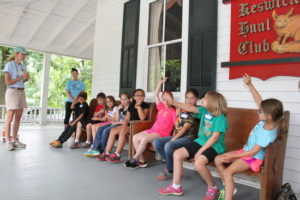 On Tuesday, June 28, Keswick Hunt Club welcomed a group of children from the Boys & Girls Clubs of Orange to their Clubhouse and Kennels in Albemarle County, Virginia. The youngsters first heard from whipper-in and historian Barclay Rives about the goals and planning involved in organized foxhunting. Nancy Wiley, MFH, a former board member of the Boys & Girls Clubs, encouraged the children to share their outdoor experiences and to be keen observers of nature and wild animals.These Boys & Girls Clubs participants quickly mastered the technique for holding their hound’s attention. Noted artist, Lee Gildea, continued this theme by displaying several of his works: paintings, carvings, and spectacular walking sticks formed from saplings twisted by honeysuckle or other vines (including one featuring whittled and painted likenesses of the Keswick pack). The children enjoyed examining the pieces and hearing Mr. Gildea explain that he began carving as a hobby while out in the woods waiting for hounds to come home.The visitors then followed Huntsman Tony Gammell into kennels, where they were enthusiastically greeted by this year’s adolescent puppies. Human and canine youngsters had a terrific time romping together and exchanging affectionate hugs and kisses. Eventually, Tony and kennelman Mike Poindexter, brought out several couples of adult hounds, and with a precautionary ratio of two children per hound (with several adults distributing biscuits and assistance as needed), the group went for a brief but energetic walk around the Keswick Horse Show grounds. All the guests had a newfound appreciation for the work involved in training and caring for hounds and some new inspiration to get outside and explore our natural world.
On Tuesday, June 28, Keswick Hunt Club welcomed a group of children from the Boys & Girls Clubs of Orange to their Clubhouse and Kennels in Albemarle County, Virginia. The youngsters first heard from whipper-in and historian Barclay Rives about the goals and planning involved in organized foxhunting. Nancy Wiley, MFH, a former board member of the Boys & Girls Clubs, encouraged the children to share their outdoor experiences and to be keen observers of nature and wild animals.These Boys & Girls Clubs participants quickly mastered the technique for holding their hound’s attention. Noted artist, Lee Gildea, continued this theme by displaying several of his works: paintings, carvings, and spectacular walking sticks formed from saplings twisted by honeysuckle or other vines (including one featuring whittled and painted likenesses of the Keswick pack). The children enjoyed examining the pieces and hearing Mr. Gildea explain that he began carving as a hobby while out in the woods waiting for hounds to come home.The visitors then followed Huntsman Tony Gammell into kennels, where they were enthusiastically greeted by this year’s adolescent puppies. Human and canine youngsters had a terrific time romping together and exchanging affectionate hugs and kisses. Eventually, Tony and kennelman Mike Poindexter, brought out several couples of adult hounds, and with a precautionary ratio of two children per hound (with several adults distributing biscuits and assistance as needed), the group went for a brief but energetic walk around the Keswick Horse Show grounds. All the guests had a newfound appreciation for the work involved in training and caring for hounds and some new inspiration to get outside and explore our natural world.
The Boys & Girls Clubs seek to “provide an after school and summer program for children and teens ages 6-18, comprised of diverse activities that meet the interests of all youth,” with the goal of “promoting and enhancing the development of boys and girls by instilling a sense of competence, usefulness, belonging and influence.” The Clubs in Orange, Virginia, have developed a nature trail adjacent to their building to encourage outdoor exploration and also visit different area farms as part of their enrichment programs.
Keswick Hunt, established in 1896, participates in several community outreach events through the year. The club has an active program for its junior members, the Keswick Cubs, including mounted, unmounted, and social activities. Staff planned to bring hounds to the Boys and Girls Clubs headquarters as a follow-up experience for the children shortly after this article was written.
Some of the best young horses in the country will come together in August at The Virginia Horse Center. The Virginia Young Horse Festival will proudly host the 2016 Sallie B. Wheeler/U.S. Hunter Breeding East Coast National Championship at the Virginia Horse Center on Saturday, August 27. Highlights will include the East Coast Best Young Horse Championship class, a party Saturday night at 5:00 p.m. in celebration of the Sallie B. Wheeler Hunter Breeding Championship. Several USEF Championship trophies will be awarded on Saturday including The Dave Kelley Perpetual trophy which will be awarded to the Overall Grand Hunter Breeding Champion. The J. Arthur Reynolds trophy, awarded to the breeder of the Overall Grand Hunter Breeding Champion, and The Foxwick Farm Perpetual Trophy awarded to the leading Thoroughbred. On Friday August 26, the Horse Center will be host to a C rated breeding show as part of the Virginia Young Horse Festival.
By Keswick Life
Written by Caroline Newman
Photos courtesy of the University of Virginia Office of Communications
 UVA grads Bradford and Bryan Manning have launched a company with a charitable aim: curing the disease that is robbing them of their sight.
UVA grads Bradford and Bryan Manning have launched a company with a charitable aim: curing the disease that is robbing them of their sight.
Each shirt in University of Virginia graduates Bradford and Bryan Manning’s new clothing line features a small metal tag imprinted with a series of raised dots – braille for “brother.”
That small detail neatly captures the mission behind the Mannings’ newly launched clothing company, Two Blind Brothers. All proceeds from the company go directly to blindness research, funding testing for new gene and stem cell therapies that could slow or even reverse vision loss.
The cause is very personal for Bradford and Bryan, who were each diagnosed with Stargardt disease in early elementary school. The degenerative eye disease, which affects about one in 10,000 people in the U.S., gradually erodes patients’ central vision, leaving them with an ever-expanding blind spot. By the time the brothers, who grew up in Charlottesville, attended UVA, they were operating with precious little central eyesight.
“We’ve developed our own systems to address problems,” Bradford said. “You ask a lot of strangers a lot of questions. I take a lot of pictures of things on my phone and then zoom in. At UVA, I almost always carried a little magnifying glass in my pocket.”
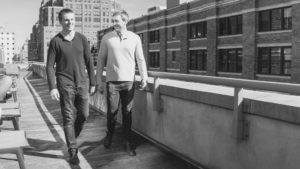 “It is really hard to recognize faces, especially of fairly recent acquaintances,” Bryan said. “You develop a habit of talking to someone and keeping it kind of ambiguous at first, until you can figure out who they are.”
“It is really hard to recognize faces, especially of fairly recent acquaintances,” Bryan said. “You develop a habit of talking to someone and keeping it kind of ambiguous at first, until you can figure out who they are.”
After UVA, the brothers ended up working in New York City. Bradford, who graduated in 2007 from the McIntire School of Commerce, is now a managing partner in a private investing firm. Bryan, who graduated with a degree in statistics in 2013, works as a sales representative for SNL Financial. Both brothers decided not to take a salary from their new company so that all proceeds from Two Blind Brothers can go directly to research.
“We are both fortunate to have incomes from other jobs and ventures, so we wanted to pledge 100 percent of all proceeds to the cause,” Bradford said.“For us, this is a new and fun vehicle to give back to a cause that means the world to us,” Bryan added.
Bradford, graduated from the McIntire School of Commerce in 2007. His younger brother Bryan, graduated in 2013 with a degree in statistics. Both brothers now live in New York City. After deciding to start the company last summer, the Mannings spent a year selecting fabrics, designing shirts and overseeing the manufacturing process. Reflecting the tactile way that they and others coping with blindness navigate the world, the brothers focused closely on the quality of the fabric and feel of the shirts. Currently, they offer casual shirts in both short and long-sleeve styles. Each shirt carries the signature braille tag, which the Mannings plan to customize based on the theme they want to convey or the location where shirts are being sold.
All of the company’s production facilities are in New York, including a fabric mill in the Bronx and a design studio in Manhattan. Building those partnerships was a key step for the Mannings, who had little previous experience in the clothing business.
“As an entrepreneur, when you have to run 100 percent of the company, you inevitably run into things that are not really your strong suit,” Bradford said. “We had to get a lot of advice and talk to a lot of experts.”
The research aspect of the company was more familiar to the brothers. Both had long been involved with the Foundation Fighting Blindness, for which Bradford serves on the board of directors. Initially, the Mannings plan to distribute proceeds from Two Blind Brothers through the foundation’s network of researchers.
“Right now, we have a list of about 10 research opportunities that we are interested in,” Bradford said. “Broadly, we are looking at a lot of gene therapy and stem cell treatments.”
Those therapies aim to alleviate blindness either by replacing diseased cells with healthy stem cells or by transplanting normal genes in place of missing or defective genes. Many companies are testing these methods with hopes to bring them to market soon.
“What is fascinating is that there is kind of a medical revolution going on with gene and stem cell therapies. Companies are already trying to commercialize these methods and treat patients,” Bradford said. “It is less a question of if it can be done and more a question of bringing the research through expensive clinical trials.”
The Mannings hope that Two Blind Brothers can raise money for those crucial clinical trials, both directly by selling their shirts and indirectly by raising public awareness. Already, they have been amazed by the attention their new venture has garnered.
“We launched a few weeks ago with a post on Facebook that has already been shared to 100,000 people. One of the best things about founding Two Blind Brothers has been the outpouring of support from friends, family and strangers,” Bryan said. “That has been the biggest positive for me.”
By Keswick Life
Historic Grace Church Celebrates Seventh Annual “beyond the gates” Farm Tour and Country Fair, Saturday June 11, 2016 What’s better than a day in the country exploring some of Virginia’s fabulous historic farms? On Saturday, June 11, 2016, visitors are invited “beyond the gates” here they may view the lands and agrarian lifestyles known to some of the nation’s founders and legendary Virginia citizens, from as far back as the 1700s. Grace Church’s Seventh Annual Historic Farm Tour and Country Fair draws hundreds of visitors to its church grounds. Transformed this day to an earlier era, the fair features local artisans, merchants, musicians, and food vendors, offering handmade items, crafts, wares and refreshments. Attracting visitors near and far, the tour includes outdoor properties along and nearby State Routes 22 and 23l, in Albemarle County. Route 231 is, in itself, a tourist attraction–a dedicated National Scenic Highway that parallels the eastern ridge of the Southwest Mountains.
Grace Church’s Farm Tour originated in 2010 to benefit the local community. Since then, the event has generated more than $250,000 in donations to local charities, including the church’s food closet, Habitat for Humanity, the Salvation Army, Meals on Wheels, and several others. For those who attend, it is a magical day listening to music, visiting farm grounds, petting animals, viewing demonstrations, and selecting souvenirs. Hours are 10 a.m. to 4 p.m. with the Country Fair and Antiques at Airslie staying open til 5 p.m.
Advance Tickets are available at www.gracefarmtour.org and at select remote locations – Fink’s (Charlottesville & Richmond), Wild Birds Unlimited (Shoppers World Charlottesville), In Vino Veritas (Keswick), The Laurie Holladay Shop (Gordonsville), Caspari, Inc. (Downtown Mall), and Jefferson Pharmacy (Lake Monticello).
“The Grace Farm Tour represents everything wonderful about living in a community that cares and gives back,” says Stevia Anda, co-chair for the event. Anne Young, co-chair also extends a warm invitation to the public: “Join us for a truly special day surrounded by the natural beauty and history of Keswick along with caring neighbors and friends.”
Vendors include: Abbey Noelle Animal portraits Chickie Dickie Jewelry Statement jewelry Charlottesville Camera Club Photo exhibit Dancing Chick Jam Delectable Hills Farm Goat milk soaps, woven rugs & linens Ellen Taylor Purses, blankets, children’s, spices, salad dressing Equine & Wine Design Wine & horse jewelry Formo Leather Co. Leather goods Forrest Green Farm Organic herbs, plants, poultry Fred Williamson Wood bowls Harry Miller Charlottesville notecards It Works Products Healthcare products Jayne Cox Book-“Thomas Jefferson, from Boy to Man” Karen Wright Custom coin jewelry (new vendor) Lux Aromatica Candles, soaps, skincare, textiles Mary Kay Charitable Foundation & Cosmetics Mary Mayo Designs Original Gemstone & Pearl Jewelry Michael Turk Turkish towels & cottons Mud Chicks Pottery Pettigrew Woodworks Handcrafted wood accessories Phineas Rose Jewelry Handmade Silver Jewelry Phineas Rose Wood Handcrafted wood furniture Posh Ladies accessories & custom clothing 3 Sharon Kinchloe Oil Paintings & botanicals Southern States Garden supplies The Woodsman’s Design Woodworking designs Wunderbars 100% Natural Body Balms Piedmont Master Gardeners Volunteer table
GRACE EPISCOPAL CHURCH
 Historic Grace Episcopal Church stands at the site of one of six colonial churches in Virginia that still have active congregations. Foundation stones of the original church, constructed of wood and completed in 1748, are visible today under spreading oak trees in front of the present structure. A mountain chapel had previously existed on the premises, having been built by the earliest settlers in the area, probably in the 1730s. From 1767 to 1770, Thomas Jefferson served as a member of the Vestry of Fredericksville Parish, which included the original church and two others in Albemarle and Louisa Counties. The present church edifice was completed in 1855 at a cost of $20,000. A fire in 1895 left only the tower and four walls standing, which were incorporated into the present structure when the church was rebuilt.
Historic Grace Episcopal Church stands at the site of one of six colonial churches in Virginia that still have active congregations. Foundation stones of the original church, constructed of wood and completed in 1748, are visible today under spreading oak trees in front of the present structure. A mountain chapel had previously existed on the premises, having been built by the earliest settlers in the area, probably in the 1730s. From 1767 to 1770, Thomas Jefferson served as a member of the Vestry of Fredericksville Parish, which included the original church and two others in Albemarle and Louisa Counties. The present church edifice was completed in 1855 at a cost of $20,000. A fire in 1895 left only the tower and four walls standing, which were incorporated into the present structure when the church was rebuilt.
A 1,575-pound bell was salvaged from the ashes and is still in use. The first annual Blessing of the Hounds service was held at the church in 1929. Each Thanksgiving Day, this colorful ceremony brings together foxhunters and their horses and hounds in the church yard for prayers and thanksgiving. The Parish House was constructed in 1933 and expanded in 1971 and 2002. Today Grace Church has over 200 members and provides personal and financial support for numerous charitable missions, including the church’s food closet, Habitat for Humanity, the Salvation Army, Meals on Wheels, the Cameroon Water project, and many others.
LINDEN LANE FARM
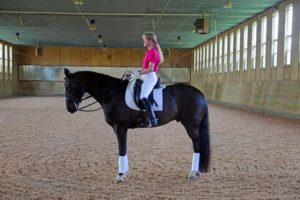 Established in the 1930s, derives its name from the linden trees lining both sides of the lane that runs through the farm. There are indications that the “lane” may have been first used by Monacan Indians prior to the arrival of the first European settlers. Thelinden trees were imported from Europe and planted along the lane in the 1930s.
Established in the 1930s, derives its name from the linden trees lining both sides of the lane that runs through the farm. There are indications that the “lane” may have been first used by Monacan Indians prior to the arrival of the first European settlers. Thelinden trees were imported from Europe and planted along the lane in the 1930s.
Today the farm is home to Bert Page and Elizabeth Lewis Page. A member of the U.S. Equestrian Dressage Team, Elizabeth represented the United States in international competitions throughout the U.S. and Europe, including the 1974 World Dressage Championships in Copenhagen, Denmark. She was also selected as the alternate team member for the 1976 Olympics in Montreal. Over the years, the farm was developed into an international enterprise, actively involved in the breeding, training and sale of dressage horses domestically and internationally. Dressage demonstrations will be presented by Elizabeth and her horse, “Da Vinci,” at 10:30 am and 12:30 pm.
MONTANOVA STABLES
Foundation’s facility is located on 50 acres at Belvoir Farm. The farm features 45 acres of paddocks, access to trails, a sand riding ring with an adjacent “jumping field,” and a beautiful 16-stall barn. Montanova Stables has been teaching horseback riding to children and adults in the Keswick area since 1996. The Foundation is one of the many organizations that have received financial support from Farm Tour proceeds.
The Foundation’s after-school program and week-long summer camps benefit children from a variety of backgrounds, helping them to develop valuable life skills such as patience, trust, responsibility, and a strong work ethic. Students gain a valuable sense of accomplishment and increased self-confidence as they learn to ride and care for horses. Montanova Stables Foundation partners with local schools and family support staff to identify children who can benefit from its horsemanship and mentoring program.
KESWICK HUNT CLUB
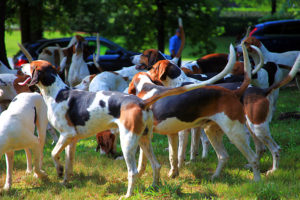 Founded in 1896. Foxhunting has been an important part of this community since 1742, when foxhounds were brought to the area by Dr. Thomas Walker of Castle Hill, who also helped found the city of Charlottesville. The Keswick Hunt Club clubhouse was built in 1898. The hunt club has hosted at least one annual horse show since 1904. Initially, the lower ring’s proximity to the railroad tracks was a convenience for spectators who travelled to the event from Charlottesville by train. The upper ring was built in 1957.
Founded in 1896. Foxhunting has been an important part of this community since 1742, when foxhounds were brought to the area by Dr. Thomas Walker of Castle Hill, who also helped found the city of Charlottesville. The Keswick Hunt Club clubhouse was built in 1898. The hunt club has hosted at least one annual horse show since 1904. Initially, the lower ring’s proximity to the railroad tracks was a convenience for spectators who travelled to the event from Charlottesville by train. The upper ring was built in 1957.
The kennels are home to approximately 70 American Foxhounds who lead mounted club members on chases in designated territory in four counties. The three-dayper-week hunting season stretches from late summer to early spring. The huntsman spends the rest of the year as well as non-hunting days during the season training the pack. A select group of the Keswick Hunt Club’s American Foxhounds are looking forward to entertaining visitors at 10:30 am and again at 1 pm on Farm Tour day!
MERIFIELDS
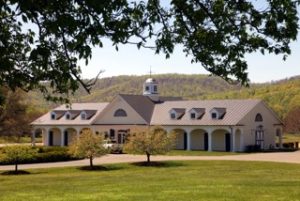 A 556-acre estate that includes land from a separate farm that was formerly known as Holly Fork. Jaffray and Merrill Woodriff acquired Merifields in 2008. The original main house dates from the late 1800s or early 1900s. A white cottage, a corn crib and silos were constructed in the mid-1900s. A guest house was built in 1996, a stable was added in 2000, and a new main residence was constructed in 2002. The latter two structures were built by R.E. Lee & Son, Inc. and were designed by Stewart Humiston and architect Boris Baranovich.
A 556-acre estate that includes land from a separate farm that was formerly known as Holly Fork. Jaffray and Merrill Woodriff acquired Merifields in 2008. The original main house dates from the late 1800s or early 1900s. A white cottage, a corn crib and silos were constructed in the mid-1900s. A guest house was built in 1996, a stable was added in 2000, and a new main residence was constructed in 2002. The latter two structures were built by R.E. Lee & Son, Inc. and were designed by Stewart Humiston and architect Boris Baranovich.
One of the estate’s most prominent former residentswas Ebenezer Boyden. In 1849 he purchased a home site there and named his residence Hopedale. Boyden served as rector of Grace Church from 1839 to 1879. During the Farm Tour, Service Dogs of Virginia (SDV) will present demonstrations at Merifields at 10:30 am, 12:30 pm and 2:30 pm. SDV helps disabled persons to gain independence, security and peace of mind. Dogs are trained in three areas: physical assistance for wheelchair users, service dogs for children with autism, and diabetic alert dogs.
LIMESTONE
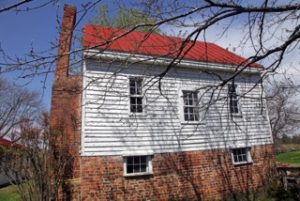 A 465-acre tract, derives its name from the discovery on the property of a portion of the largest vein of limestone east of the Mississippi. Thomas Jefferson owned four acres of Limestone in the 1760s, where he established a kiln and a slacking pit. With the lime, sand, and water, he produced the mortar that was used to build Monticello and the University of Virginia.
A 465-acre tract, derives its name from the discovery on the property of a portion of the largest vein of limestone east of the Mississippi. Thomas Jefferson owned four acres of Limestone in the 1760s, where he established a kiln and a slacking pit. With the lime, sand, and water, he produced the mortar that was used to build Monticello and the University of Virginia.
James Monroe purchased the land in 1800, practicing law there in a wood frame structure that dates to 1794. Later, the property was owned by George Blatterman, who was hired by Thomas Jefferson as the first professor of languages at the University of Virginia. Between two early 18th century structures, Blatterman added the Neoclassical Revival style center portion of the residence that exists today.
Limestone’s current owners purchased the property in 1992 and have placed it under a conservation easement. Limestone is on the list of Virginia Historic Landmarks and the National Register of Historic Places. During the Farm Tour, the first floor of Monroe’s law office will be open to visitors.
KINLOCH
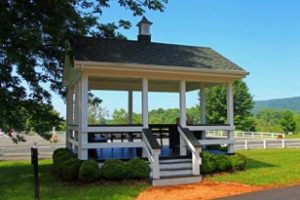 This farm once belonged to a larger holding called Belvoir that was part of the Nicholas Meriwether Crown Grant of 1730. The first house on the property was built in 1764 as the farm manager’s house. In 1765, the farm was purchased by Col. John Walker, former aide to George Washington and friend and legal guardian of Thomas Jefferson. When Belvoir passed to Walker’s granddaughter, Eliza Kinloch Walker Nelson, whose husband, Hugh, was a Congressman (1811-1823), the house was named after Eliza’s Scottish ancestor, Francis Kinloch of Charleston.
This farm once belonged to a larger holding called Belvoir that was part of the Nicholas Meriwether Crown Grant of 1730. The first house on the property was built in 1764 as the farm manager’s house. In 1765, the farm was purchased by Col. John Walker, former aide to George Washington and friend and legal guardian of Thomas Jefferson. When Belvoir passed to Walker’s granddaughter, Eliza Kinloch Walker Nelson, whose husband, Hugh, was a Congressman (1811-1823), the house was named after Eliza’s Scottish ancestor, Francis Kinloch of Charleston.
Over the next 150 years, Kinloch grew to include four tenant houses, a barn, garage and a lakeside log cabin. A major overhaul of the house by the Masseys in the 1930s brought Kinloch into the 20th century, including the addition of a library and extensive gardens. Under the Massey ownership, Kinloch continued to be a center of social activity and their friend, William Faulkner, stayed in one of Kinloch’s cottages while he wrote The Mansion. Join us for Jumping/Hunt Team Demos 11:30 am and 1:30 pm.
AIRSLIE FARM
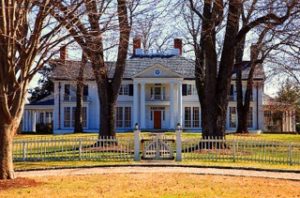 The main residence was built by descendants of the Meriwether family around the turn of the 20th century, but was completely renovated in the 1990s. Designed by Charlottesville architect Robert L. Paxton, the renovations provide an elegant atmosphere, integration of indoor and outdoor spaces, and an abundance of natural light. The classical massing of the entry elevation includes a bluestone portico with Doric columns.
The main residence was built by descendants of the Meriwether family around the turn of the 20th century, but was completely renovated in the 1990s. Designed by Charlottesville architect Robert L. Paxton, the renovations provide an elegant atmosphere, integration of indoor and outdoor spaces, and an abundance of natural light. The classical massing of the entry elevation includes a bluestone portico with Doric columns.
The central block is highlighted with Quioned corners and a Chippendale widows walk atop the slate roof. The two-story entrance hall is finished with marble flooring, raised panel wood and Zuber wallpaper. Flanking the hall are spacious living and dining rooms with antique heart pine flooring and raised panel wood wainscoting. A study with fireplace and 12-inch wide antique heart pine flooring also adjoins the living room. Each room in the residence includes a fireplace with marble surround, triplehung windows, and French doors, which access covered terraces or landscaped courtyards. The barns and cottages in the back of the 507-acre property still reflect the architectural style of an earlier time. The first floor will be open to host to a special antiques dealer show (open 9am – 5pm).
OLD KESWICK
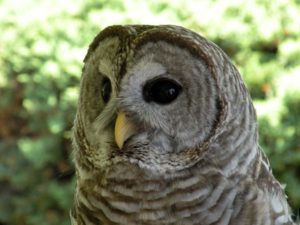 Part of a tract that was given by Thomas Walker to his daughter, Jane Frances Walker, who married Dr. Mann Page. The estate’s residence was built in stages, beginning with a log house in 1736. Originally called Keswick, the farm remained in the Page family until 1952, when it was sold to Mr. and Mrs. Ellsworth Augustus. Keswick Stables was formed at Old Keswick as a major Thoroughbred breeding and racing operation. Over the years Keswick Stables has sold many notable horses, including Sabin, Simply Majestic, Alwuhush, Eishin Guyman, Johnny D, Raise a Native, Natalma, and the 2015 Eclipse Award winning three-year-old filly Stellar Wind. Today Old Keswick is the home of eight foster horses from the Thoroughbred Retirement Foundation, which will have horses available for adoption at Old Keswick’s yearling barn. Also at the yearling barn, The Wildlife Center of Virginia will display rescued birds and animals.
Part of a tract that was given by Thomas Walker to his daughter, Jane Frances Walker, who married Dr. Mann Page. The estate’s residence was built in stages, beginning with a log house in 1736. Originally called Keswick, the farm remained in the Page family until 1952, when it was sold to Mr. and Mrs. Ellsworth Augustus. Keswick Stables was formed at Old Keswick as a major Thoroughbred breeding and racing operation. Over the years Keswick Stables has sold many notable horses, including Sabin, Simply Majestic, Alwuhush, Eishin Guyman, Johnny D, Raise a Native, Natalma, and the 2015 Eclipse Award winning three-year-old filly Stellar Wind. Today Old Keswick is the home of eight foster horses from the Thoroughbred Retirement Foundation, which will have horses available for adoption at Old Keswick’s yearling barn. Also at the yearling barn, The Wildlife Center of Virginia will display rescued birds and animals.
By Keswick Life
Come out and enjoy the competition at the historic showgrounds in Keswick and remember the Keswick Horse Show Foodstand will be serving their fabulous food- breakfast, lunch and dinner!
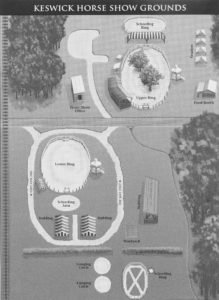 The 112th annual Keswick Horse Show will again be held at the historic Keswick showgrounds from Tuesday, May 17th through Sunday, May 22nd.This year’s show is brought to you by the Keswick Hunter Jumper Foundation.
The 112th annual Keswick Horse Show will again be held at the historic Keswick showgrounds from Tuesday, May 17th through Sunday, May 22nd.This year’s show is brought to you by the Keswick Hunter Jumper Foundation.
Keswick has maintained its excellence as a AA rated World Champion Hunter Rider Event and in 2014 was honored by the USEF as a designated Heritage competition. The designation of a USEF Heritage competition is reserved for competitions that have been in existence for a quarter century or more, promoted and grown equestrian sport and made contributions to the community outside the gates of the horse show by achieving, maintaining and promoting the equestrian ideals of sportsmanship and competition. These shows have become a part of the fabric of the American showing scene. With their endurance, dedication to philanthropic efforts and impact on their communities, they are perfect examples of what they look for when designating Heritage Competition.
Douglas Wheeler and Meredith McLaughlin are again co-chairman of the show assisted by numerous committees of Keswick volunteers. The Keswick Horse Show has always been known for its entertainment and this year again as always the committee has created a wonderful schedule of events.
On Wednesday evening grab your dog , practice your tricks and get your best costumes ready for the 28th annual Eastminster Dog Show For over 25 years, CO-chairs Peggy Augustus and Ginny Semmes have continued to host this wonderful family event. The SPCA is so grateful for supporters like Ginny and Peggy not only because the show has evolved into a Charlottesville tradition but it is a fun time for everyone.
Dogs and their families are invited to compete in fun-filled classes of competition, including Best Costume, Best Trick, Best Family, Musical Chairs, Best Rescue, Beginner Obstacle Course and Best in Show. Registration for the family friendly event begins at 5:00 pm with the show starting at 6:00 pm. Of course spectators are welcome. Admission and entry is free but donations to the SPCA are encouraged.
The weekend starts with the USHJA National Hunter Derby followed by dinner under the tent on Friday night. Saturday is always a special gathering for the entire community featuring the $20,000 UVA Children’s Hospital Jumper Classic. It is a beautiful evening that has become a tradition in Keswick. Sunday’s Down Home Fish Fry on the porch is a relaxing conclusion to a wonderful week. The horse show features classes for Hunters and Jumpers Wednesday through Sunday beginning at 8 am with classes on Friday and Saturday evenings.